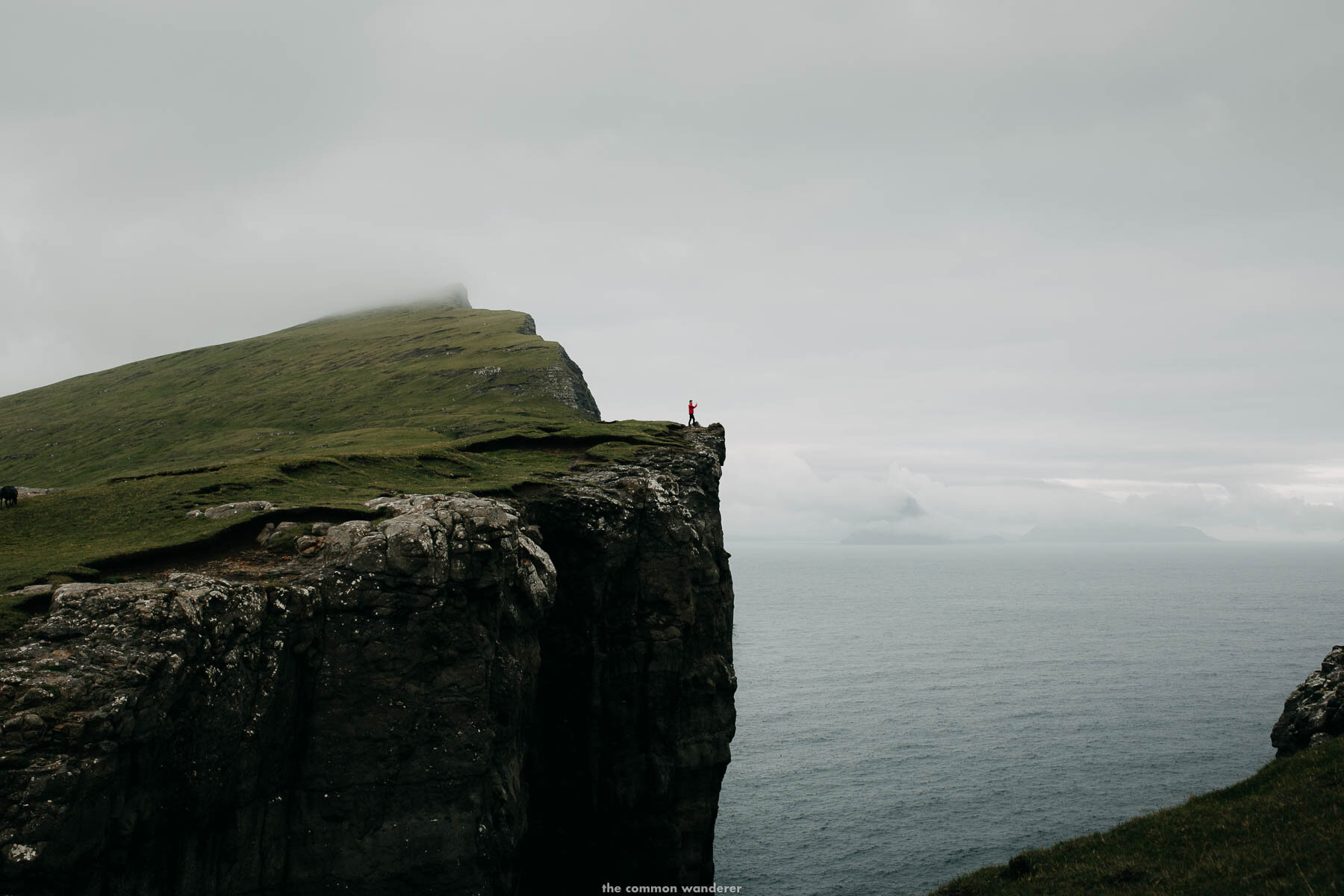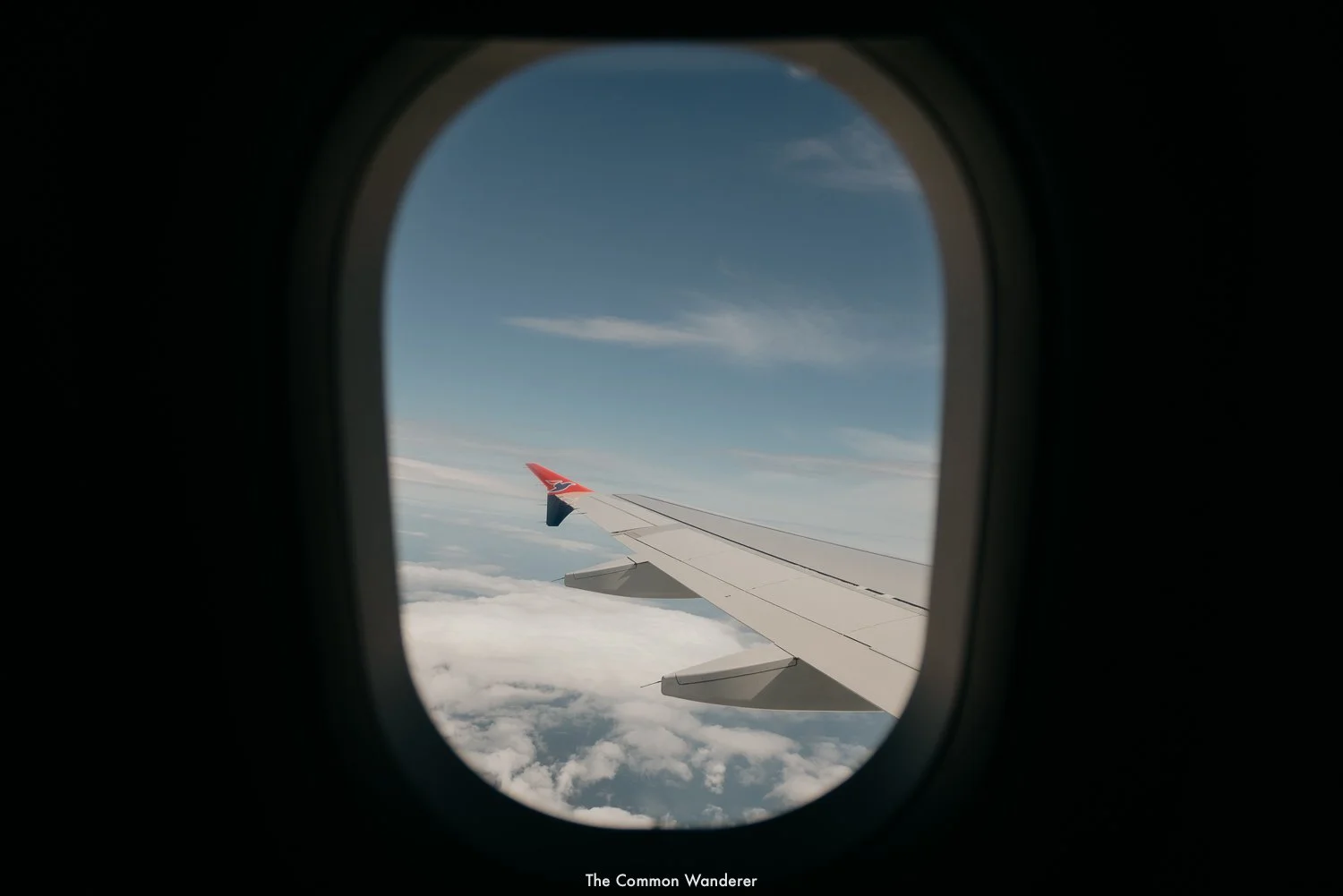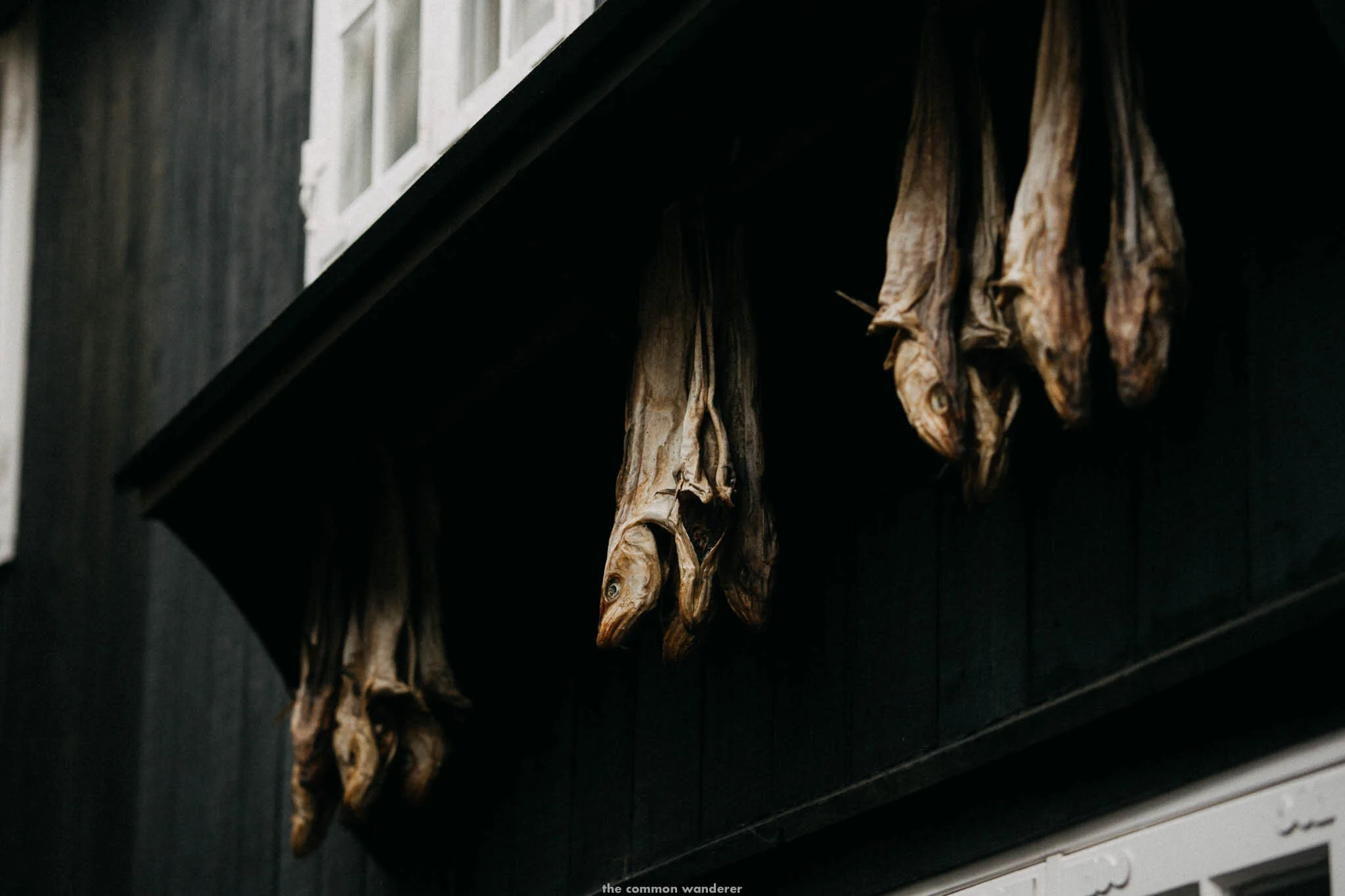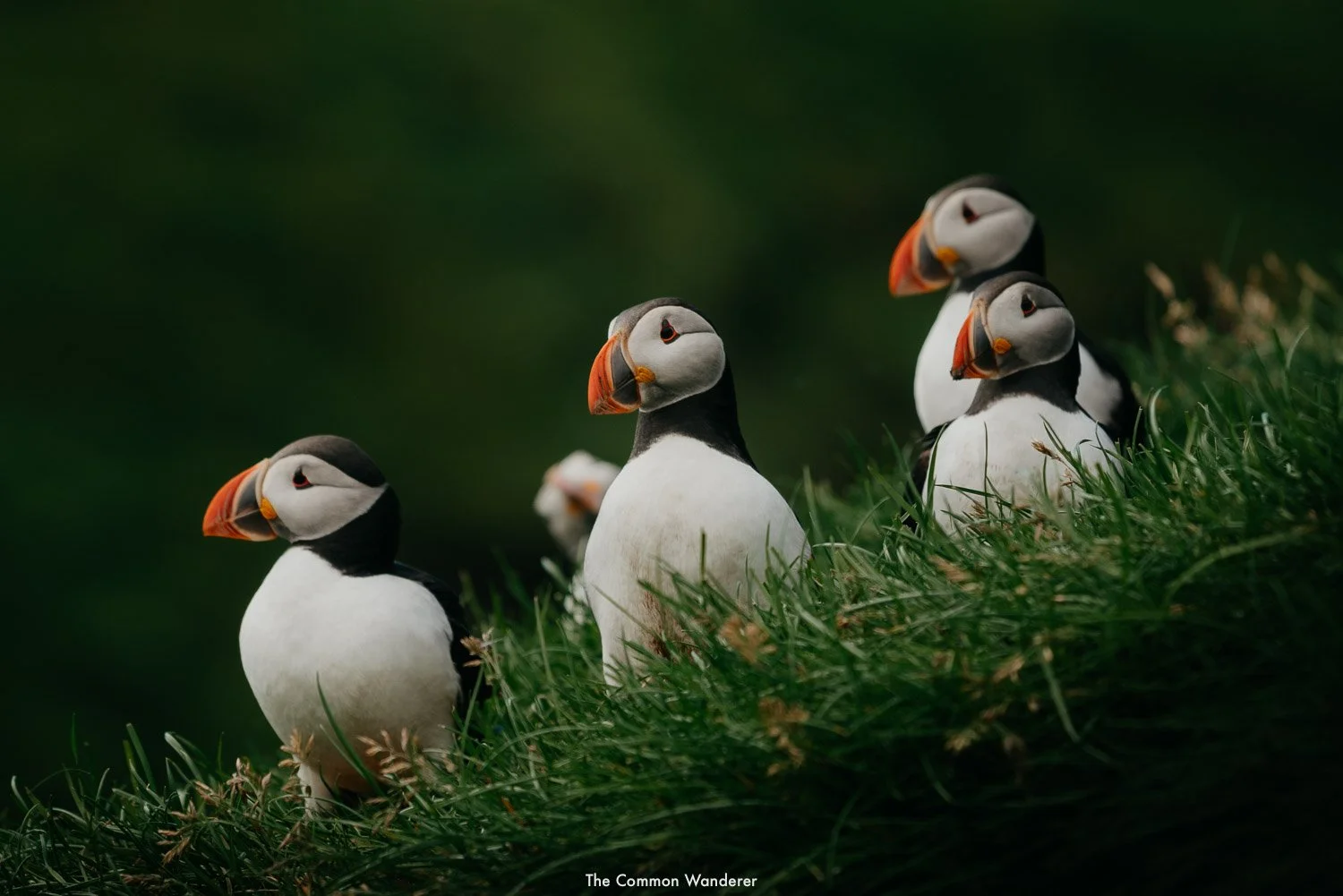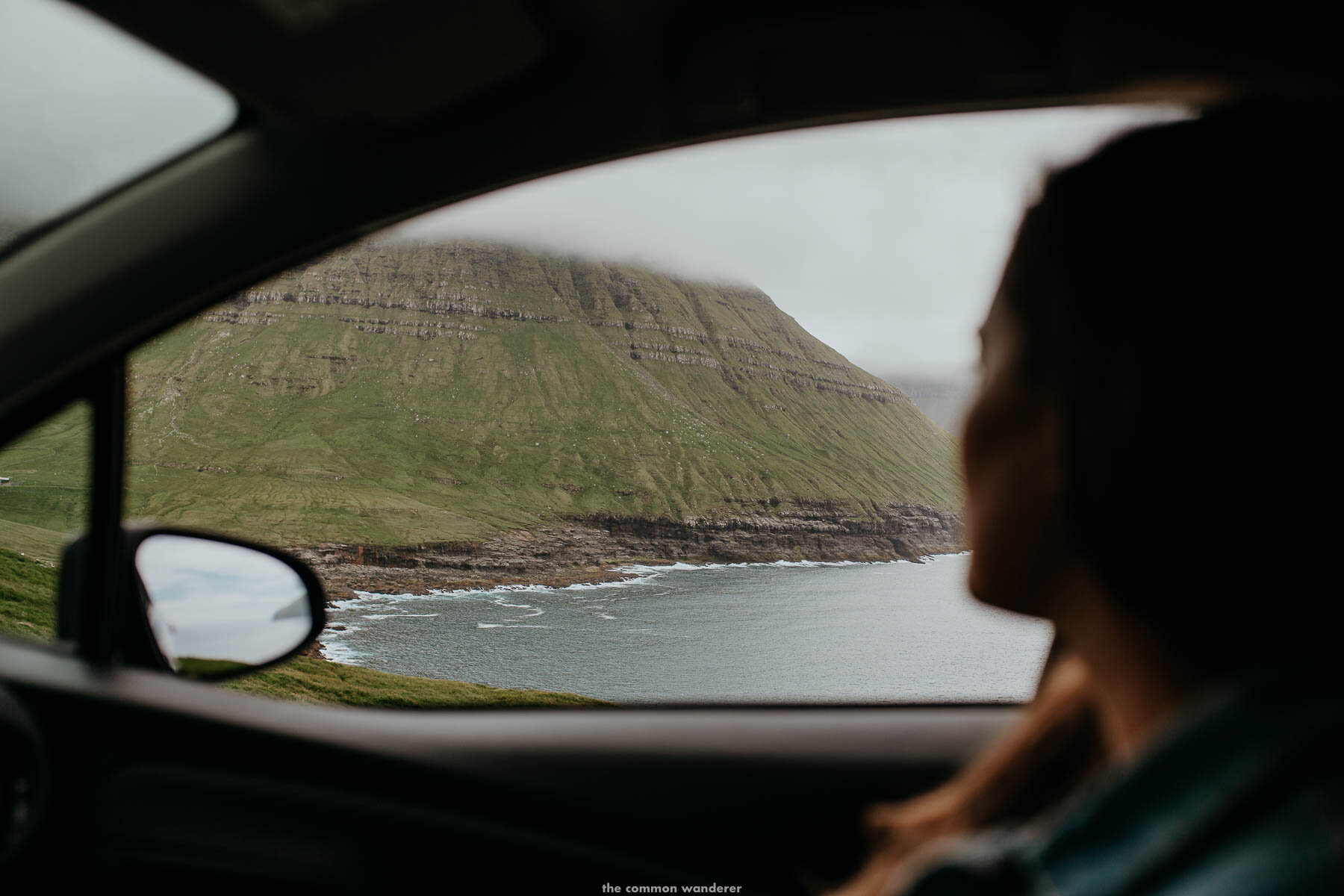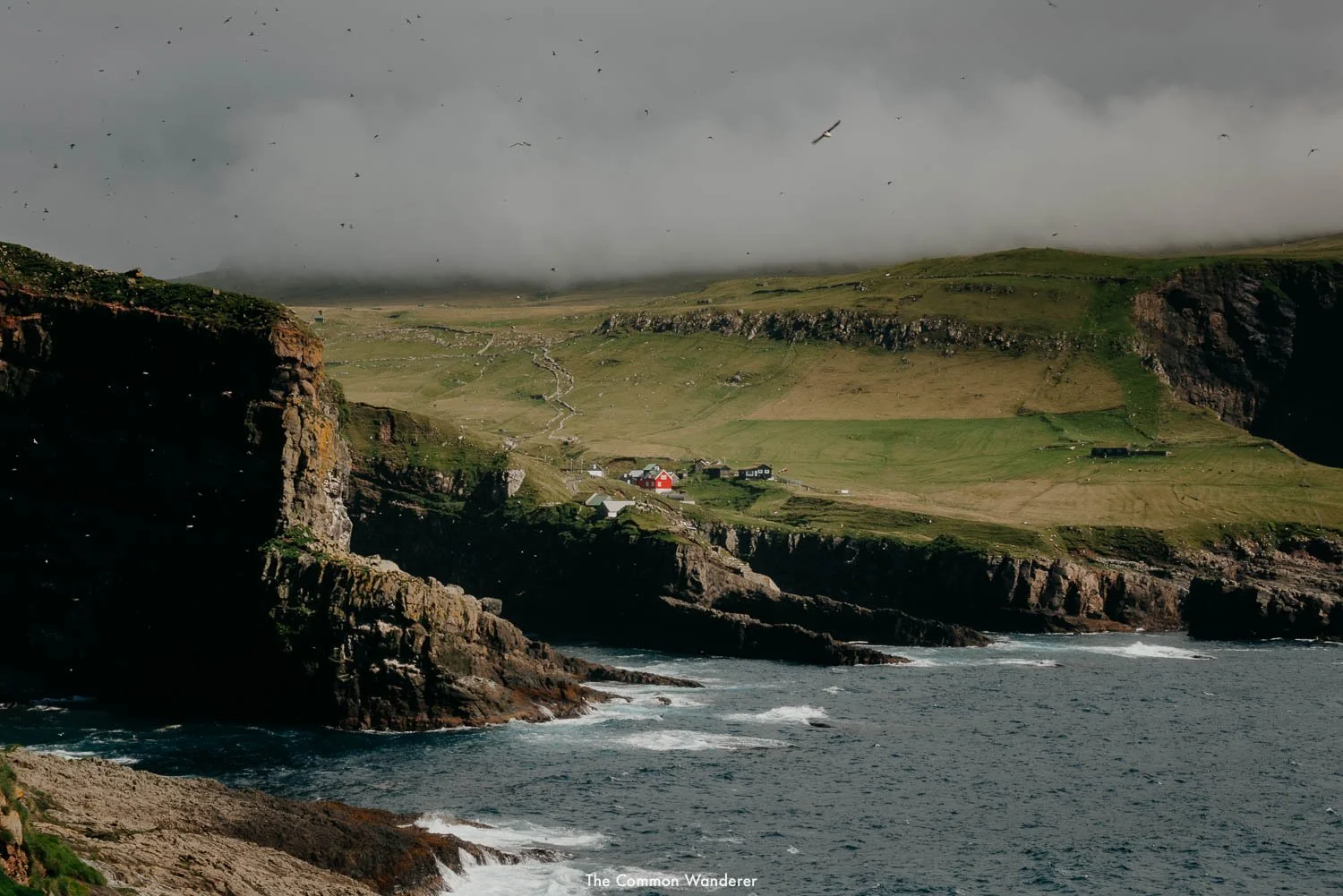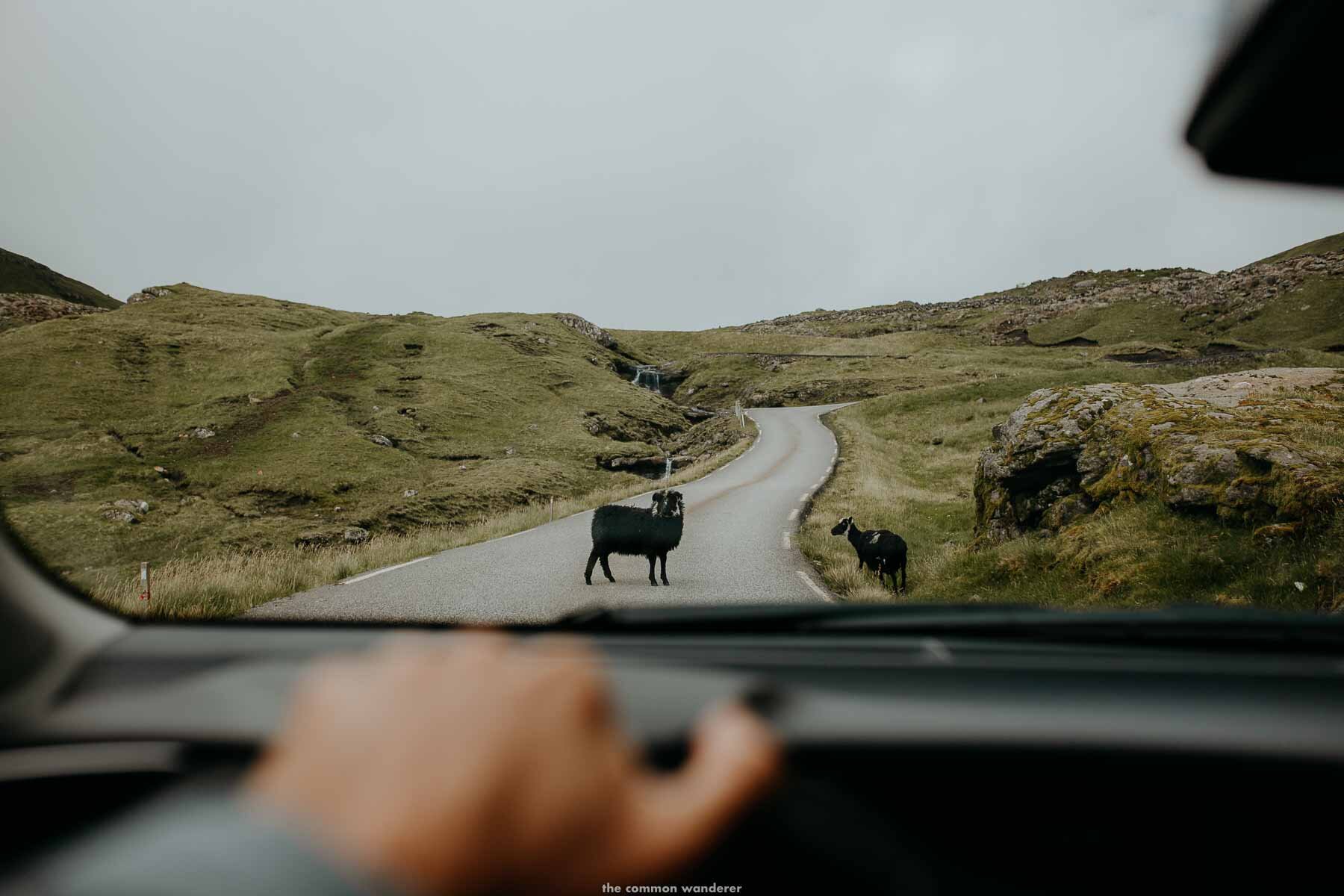22 Essential Things to Know Before Visiting the Faroe Islands
Want to travel to the Faroe Islands but not quite sure where to start?
From how much things cost and how to get around, to safety advice and the photography gear you need - these are our essential Faroe Islands travel tips!
UPDATED - July 2024
Rugged. Beautiful. Wild.
Oh, and somewhere in the North Atlantic Ocean.
Until recently, that's pretty much all we knew of the Faroe Islands, a craggy cluster of Volcanic islands somewhere between Iceland and Scotland. In fact, we have to admit that our knowledge was built almost exclusively upon the Insta-famous photo spots, and the tiny dots in the big wide blue that Google Maps had reduced this little nation to.
But in late July we road-tripped around the island, getting to know its extraordinary landscapes, its quaint seaside villages, and its friendly and welcoming people. We marvelled at its sweeping green valleys and dramatic sea cliffs, hiked its narrow fjords and pointed peaks, and of course, got overly excited when a colony of Puffins soared over our heads.
It was a week of outdoor magic, and it was with great reluctance that we finally boarded our flight back to Edinburgh.
In many ways, arriving with little to no knowledge of Faroese land or culture was brilliant, because it allowed us to see everything with fresh, unprejudiced eyes.
That said, there were a few things we wish we'd known about travelling in the Faroe Islands ahead of time; small things here and there that would have made our trip planning easier (and saved Mim trying to plot our route there via rowboat!) - which is why we're sharing our tips on the essential things to know before visiting the Faroe Islands with you here.
22 ESSENTIAL FAROE ISLANDS TRAVEL TIPS
#1 THE WEATHER IS ETERNALLY UNPREDICTABLE
There's one thing that will underpin your entire trip right from the very start: the only thing predictable about the Faroe Islands’ weather patterns is that they are wildly unpredictable. In fact, there's actually a saying in the Faroe Islands that if you don't like the weather, wait five minutes - something we came to understand within the first few minutes of being there.
The reason for this huge weather variation is the Faroes position in the middle of the North Atlantic. Here, the warm waters of the Gulf Stream swirl around with the icy waters of the Arctic, creating the perfect melting pot for some pretty crazy weather concoctions.
You'll never really know what's in store for you each day - though grey skies, cloud, and wind are a pretty safe base level to work off - once you've accepted that fact, the islands become a fascinating adventure through the weather. It does pay to have some flexibility in your planning, as ferries will get cancelled in poor weather conditions and your plans may shuffle around.
Having just told you how intense the weather patterns in this part of the world can be, we realise it's probably a little weird for us now to be claiming that the temperatures are reasonable. But despite their position in the North Atlantic, the Faroe Islands climate (at least temperature-wise) really is a pretty mild one.
In winter, temperatures average about 2-6° (not much cooler than London!), while summers are cool and breezy with an average temperature of 12°. It's definitely not the destination to come if you're looking to work on that summer tan, but we promise the epic, rugged views definitely make having to pack a few extra layers worthwhile!
Note | While the temperatures are pretty mild, the wind is anything but. We travelled through the islands in the height of summer, and some days the wind gusts were forecast at 55km/h - which is not a gentle breeze by any stretch. Always be aware of wind conditions before you set off for the day, especially if you're planning to go hiking in some of the mountains.
#2 ALWAYS PACK A RAIN JACKET, WARM JACKET, AND SOME SNACKS FOR ‘JUST IN CASE’
The sun might be shining when you leave your hotel room in the morning, but trust us: when you're in the middle of a hike and the skies open up with pouring rain, you'll never regret throwing some warm waterproof gear in your daypack.
If you need to wait out a storm or the weather leaves you stranded, it's always safe to have some extra water and some snacks with you too. Remember, the weather changes quickly, and it can be powerful - so always err on the side of caution!
Keep an eye out over the next few weeks for our essential Faroe Islands packing guide!
#3 GETTING TO THE FAROE ISLANDS IS EASY
A series of small, but rugged, specks in the north Atlantic Ocean, the Faroe Islands definitely have an 'end of the world' feeling to them. But while they're definitely remote, getting to them really isn't as difficult as you might think at first glance of your Google Maps. Here are some of the ways you can get to the Faroes yourself!
BY AIR
These days, the Faroes national carrier, Atlantic Airways, fly from Edinburgh (this is how we got there!), Copenhagen (Denmark), Bergen (Norway), Reykjavik (Iceland), Paris (France) to Vagar airport year-round, with a flight time of around 2-hours for each. Scandinavian Airlines (SAS) also fly a route from Copenhagen too.
We flew Atlantic Airways from Edinburgh, and our flight was just an hour - insane when you consider the islands really are one of the world's most remote, wild destinations. Atlantic Airways flights also operate from Barcelona, Mallorca, Gran Canaria, Crete and Malta on a seasonal basis too.
Prices are also pretty reasonable for the adventure of a lifetime; between £100-150 return from Edinburgh with Atlantic!
BY FERRY
If you have the time, the taste for adventure, and a love for slow travel, you can also take a ferry to the Faroe Islands.
The Smyril Line operates services between Denmark (Hirtshals), the Faroes, and Iceland twice a week in summer, and once during winter. Each trip takes about 37 hours and you can take your car on board too!
#4 THE FAROE ISLANDS ARE TECHNICALLY PART OF DENMARK
You - like us - will probably be surprised to learn that the Faroes are thought to have one of, if not the, oldest continuing parliaments (Løgtingið - over 1,000 years old) in the world. However, despite their historical legacy, they're actually not formally recognised as an independent country today.
For many years, the Faroes were considered a county of the Kingdom of Denmark, until they were officially recognised as a self-governing state under overall Danish rule in 1948. The Faroese also hold two seats in the Danish Parliament.
Despite this, the islands operate almost entirely autonomously - and don't expect Faroese people to consider themselves Danish. They have an incredibly strong cultural identity, their own language and (recognised) flag, and from what we could see through our travels there, a real passion for their home and deep pride in being Faroese.
As one of our hiking guides shared, "we voted for independence, Denmark flat out said no. That was the end of that story".
Interestingly, though they are "technically" Danish, the Faroes aren't members of the EU, having refused membership when Denmark signed up on the basis of fishing limits.
This means that some travellers may need to organise a separate visa to visit the Faroe Islands - you can find all the information you need for a Faroe Islands visa here.
SO DO YOU NEED A VISA TO VISIT THE FAROE ISLANDS?
If you’re a citizen of an EU member country, or Schengen member country, or the Nordic nations, you do not need a visa to visit the Faroe Islands. This does not apply to foreign residents.
We suggest bringing your passport, however, EU citizens may use their ID card to enter the country.
Visitors from outside the EU and Schengen area must hold a valid passport to enter the Faroe Islands. Depending on your nationality, a visa may also be required.
The nationalities requiring a visa for entering the Faroe Islands are the same as for Denmark and can be seen here.
NOTE | The Faroe Islands are NOT part of the Schengen Area, so you cannot enter the Faroe Islands based on your Schengen visa or Danish visa. When a visa is applied for at the Danish Embassy, it must be specifically for the Faroe Islands.
#5 THERE ARE SOME LONG-HELD TRADITIONS IN THE FAROE ISLANDS THAT ARE CONFRONTING | THE GRIND
If you've googled the Faroe Islands in the past, chances are you've already seen the images and read the stories about the annual Grindadrap; the Faroese whale hunt.
The images are hard to forget once you've seen them; blood-red oceans, gutted dead whales piled up along the shore, men covered in blood holding knives in their hands.
They’re gory and devastating, and we really have to make it clear here, as vegetarian travellers / vegans at home with a commitment to ethical and sustainable travel - we do not agree with the annual Faroe Islands whale hunt.
Having travelled through the islands during our one-week trip, spoken with many locals about it, and reading up on it extensively ourselves, we can, in some small way, understand the context of why the hunt began in the first place. The issue is complex and nuanced, and there’s a great deal of passion involved on both sides.
When it comes to crops and agriculture, the Faroes are wild and desolate. Only 2% of the land is arable, and when it is, only root veggies like potatoes, turnips, and rhubarb grow. For centuries, the Faroese survived on whale meat and other meals brought to them by the seas; fish, shellfish, and seabirds. There were sheep, yes - but not enough to consistently feed entire populations and be sustainable and provide enough wool for clothing and economy.
When it began, the whale hunt was born from sheer necessity. It became integral to the way of life and identity of the Faroese, and for those who participate in it, it's seen as the most sustainable way to source meat by saving millions of Kroner and energy consumption in transporting beef from across the world instead (this article sums it up well).
Thankfully, we didn't witness any of the hunts ourselves, though we found many Faroese chatted about them and their love for whale meat/blubber in the same casual way that someone in London would talk about a good steak - something we found awkward and confronting.
From our perspective, modern humans have become seriously disconnected from where and how their food is sourced. Many who criticise the Grind also consume mass-produced, supermarket-purchased animal products in their home country. If someone is arguing over the ethics of animal slaughter in a far corner of the world, then we sincerely hope they’re also cognisant of the way meat is processed in their home country, and actively making decisions not to participate in the industry in any way.
For us personally, we don’t and never will agree with the Grind for a multitude of reasons, and we don’t believe it has any place in the modern world. We want to see it end as soon as possible.
At the end of the day, we’ve travelled to and lived in many countries where we’ve strongly disagreed with policies, cultural events, or history because we believe most countries and their locals are more than their most famous negative trait.
Listening and trying to understand someone else's way of life - even if you don't agree with it - is such an important part of travel, and we encourage you to try and do the same on your own travels there too.
2024 NOTE | Since we wrote this post in 2018, the issue of the Grind has evolved (and not positively). We’re currently working on a standalone post regarding the Grind, so watch this space.
READ MORE | Our guide to ethical animal tourism, and how to be a more responsible traveller
puffins and adventure: the ultimate day trip guide to mykines island
#6 THE FAROE ISLANDS HAVE BEEN INHABITED FOR ALMOST 1500 YEARS
It seems insane that such a windswept, isolated and seemingly harsh landscape could have been happily inhabited for thousands of years, and yet, since the sixth century, the Faroe Islands have been home to Irish hermit monks, Norwegian Viking settlers, and of course, a whole lot of sheep.
Much of their language, culture, and food is derived from old Norse traditions, and it's pretty fascinating when you really delve into it (read more here).
Today, the Faroese population numbers about 50,000, and the islands are home to a pretty diverse range of nationalities.
From Hungarians to Thai, Swiss to Danish, we met plenty of people who have moved to the islands from all over the world for study, work, a change of pace, or love in recent years!
#7 THE FAROE ISLANDS ARE PRIME BIRDWATCHING TERRITORY
To date, something like 305 species of seabirds has been found to inhabit the Faroes, which is insane when you consider the size of this tiny nation in the sea.
From Gannets to Fulmars, Loons to Petrels, and the biggest drawcard of all, the adorably clumsy and clownlike Puffins, birdwatchers have an absolute feast for the eyes awaiting them pretty much everywhere.
One thing to keep in mind with the Puffins is that they're only there in the summer, and the best viewing spot is on Mykines where you can actually walk through the enormous colony.
Note: you now need to pay DKK 100 to hike near the Puffin colony in an attempt to try and a) control visitor numbers and b) support conservation efforts. It's totally, 100% worth paying to see them though!
READ | Our ultimate guide to Mykines, the Faroe Islands bird-watching paradise
#8 ENGLISH IS WIDELY SPOKEN IN THE FAROE ISLANDS
As in most Scandinavian countries, English is extremely widely (and often perfectly) spoken in the Faroes - which is super lucky considering Faroese is a seriously daunting language.
Beyond 'takk fyri' (thanks), we found even the most basic of phrases near impossible to pick up, which probably isn't surprising considering there are almost 40 words for fog, and all of them sound very hard!
Faroese also isn't included on Google Translate yet, which has become the subject of a bloody awesome campaign (seriously, just watch it here), aptly named 'Faroe Islands Translate', where local Faroese volunteers translate phrases by video for you.
But don't worry if your translation is taking a while to come through - everyone we chatted with spoke brilliant English!
That being said, we suggest learning a few basic Faroese phrases to, ya know, be a better tourist!
Below are a few key phrases:
Hi - Hei (pronounced as Hey)
Goodbye - Bei (pronounced as bye)
Thank You – Takk (pronounced as Tahk) or takk fyri'
Do You Speak English? – Tosar Tú Enskt? (pronounced as“Toah-sar Too Enskt”)
Yes - Ja (pronounced as Yah)
No - Nei (pronounced as Nai)
#9 THE FAROE ISLANDS ARE NOT A BUDGET DESTINATION, BUT YOU CAN MAKE IT WORK
The Faroes have a reputation for being pretty expensive - but with a little forward planning and some smart budgeting, your travels there absolutely don't need to break the bank.
ACCOMMODATION
As with most places, your biggest expense here is accommodation, and sadly it really is unavoidably expensive here!
Camping is your cheapest option - although not without its risks! With inclement weather being a regular visitor around here, you'll want to be adequately prepared for the wind and rain that it brings. Note: wild camping is illegal here, but there is a stack of official camping sites around the islands. Find out more here.
For more secure lodgings, a room in a budget hotel is between £45-80, and prices increase substantially as you move into the mid- and luxury-range hotel rooms.
In our experience, there aren’t really hostels on the archipelago either - the only one that was a reasonable price during our visit has increased in price significantly since.
Airbnbs tend to provide better value, with a private room around the £45 mark, and an entire apartment £95+ per night - plus the ability to cook your own meals.
CAR HIRE
Once that cost is out of the way, public transport is pretty much equivalent to London transport prices. A multi-day travel pass will get you 4 days of travel on any bus or ferry (except the one to Mykines) for DKK500, while the Tórshavn bus is actually free around town. We'd recommend hiring a car if you can, as it gives you the flexibility and freedom to travel on your own terms.
Rentals tend to be around £40 for one day, and about £80 per day for 1 week +.
If we ever travel back to the Faroes, we've already agreed that we'd probably rent a Campervan which works out to be about £80-90 per day for a week-long trip in peak season instead - which covers your accommodation and car each day with no hassles!
FOOD
Food is obviously expensive if you're planning to eat in restaurants each day, but you can absolutely minimise this by buying food at the supermarket for your breakfast and lunches. We also had noodles for dinner in our hotel room for a couple of nights to save money! #Glamlife.
The prices for food aren't drastically different to prices back in London, but we ended up doing a big shop in Edinburgh and bringing all our snacks etc. over with us on the flight just in case.
For meals in restaurants and bars, you’re looking at between £15 - £30 (€17 - €35) per person, while alcoholic drinks can be expensive.
HIKING FEES
Since our visit in 2018, a number of popular destinations and attractions have implemented hiking fees.
To understand why, you've got to understand that most of the land on the Faroe Islands is privately owned by local farmers, and is already designated as grazing land.
This is hugely controversial across the island and amongst tourists, and while we agree a fee should be charged for the upkeep of infrastructure, and for land use, the fees charged are frankly ludicrous - Lake Sørvágsvatn, for instance, charges 200 DKK per person, which equates to approximately $30 USD for the 2-hour hike.
Similar fees apply on Mykines, Saksun, and many other sites.
Whether you agree with it or not, you definitely need to add hiking/attraction fees to your Faroe Islands budget.
#10 THE FAROE ISLANDS ARCHIPELAGO IS VERY WELL CONNECTED
The Faroese definitely don't muck around when it comes to perfecting easy connections between the 18 islands and their villages. In years gone by, some villages, like Gásadalur, were so isolated from the rest of the islands that you could only hike in and out of them. Others were only accessible by ferry, and sometimes only at certain times of the year thanks to the weather.
Over the last few decades, the government has been heavily investing in inter-Faroe Islands transport infrastructure, with a number of tunnels (both mountain and deep-sea) and bridges that connect whole islands to neighbours that were only accessible by ferry now becoming the norm.
Deep-sea tunnels operate between Vágar and Streymoy, Eysturoy and Borðoy (where Klaksvík is), and there are two more in the works literally as we speak.
This kind of infrastructure is extremely important at a time when many of the small villages are struggling with the departure of many residents to the bigger cities of Tórshavn or Klaksvik. Easy links mean these more remote communities remain viable and don't get left behind as the rest of the islands develop.
Note | Tunnels charge a toll payment of between DKK 100 - DKK 175 for one way, and DKK 350 for return trips, and you can pay at one of the petrol stations listed here. Also, some tunnels are one-lane with pull-out zones, so always be careful and watch your speed!
#11 FAROE ISLANDS PUBLIC TRANSPORT IS SURPRISINGLY GOOD
Perhaps naively, we really didn't expect to see any public transport on the Faroe Islands- and yet here, in the middle of the North Atlantic ocean, is a typically Scandinavian fully functioning, super-efficient bus system.
You'll be able to get to most places by bus, although for spots a little further out of the way (Saksun, for example), you'll either need to rent a car or find some buddies to carpool with.
As we said earlier, all 6 of the bus routes within Tórshavn are free, including one that travels to the nearby historic town of Kirjubøur
Obviously being an archipelago, ferries are a major way of travelling between islands and these are also subsidised by the government so they're super cheap (generally about DKK15 / GBP 1.80). They also run multiple trips a day to most places, and they generally have both warm seating areas inside and space on the decks to enjoy the trip outside too.
Check out bus and ferry timetables here. Note: the ferry to Mykines ( for the Puffins!) will often be cancelled in bad weather, so always keep an eye on this website to keep updated on cancellations.
Another unexpected, and surprisingly cheap method of transport here are actually Helicopters! These are sometimes the only way of accessing villages in the winter months, and they're subsidised by the government to allow citizens to travel between islands easily and cheaply.
Tourists can book a place on one if they're free, however, it's expected that you'll only take this one way (and ferry back!). More info can be found here.
TRAVEL TIP | Buses in Tórshavn are free
#12 THE FAROES ARE A GREAT ROAD TRIP DESTINATION
The images we've all seen of the Faroe Islands are of a wild and rugged landscape that looks harsh and tough to travel through. To be honest, we kind of expected lots of mud and tough 4x4 off-roading conditions for most of the trip.
This couldn't have been further from the truth!
Almost all of the roads are paved and really well maintained with only a few gravel exceptions. Roundabouts control the traffic in most cases (there are only 3 traffic lights in the entire country), and while a few of the roads are one-lane (with turnouts for passing), we never had any issues with heavy traffic.
Our little Toyota Yaris hatchback handled it all perfectly! It's also worth noting the speed limit is 80km/h on main roads and 50km/h within urban areas.
But what really makes the Faroes the most incredible road trip destination is undoubtedly the views.
Each corner and bend had us gasping and reaching for our cameras; beautiful roads snaking through valleys, insane lookout points, and ever-present sea views make for some truly epic days on the road.
Related | Our complete Faroe Islands road trip itinerary
#13 PARKING IN TÓRSHAVN CAN BE A REAL PAIN
Driving in the Faroes is awesome - parking in the capital city of Tórshavn however, is not. On our first night, we drove into town expecting to find a free car space pretty easily.
Turns out, not only are parking spaces difficult to come by in the town itself, often they're restricted to just a couple of hours each between 9am - 6pm.
This meant we either had to risk a parking fine (which we risked a couple of times without consequence - but if you get caught, it's not on us!), or park at the free parking space down near the harbour. A little annoying, but it is what it is.
Note: all cars need to display the time they parked on the little meter disc on the front windshield. If your rental car doesn't already have one, you can pick one up from the info centre.
wild islands: our guide to kalsoy and the kallur lighthouse
#14 MOST LAND IN THE FAROES IS PRIVATE, SO DON’T TRESPASS
Honestly, this is a point we can't stress enough.
Too often during our travels, we heard locals complain about tourists who felt they could come to the Faroes and behave extremely poorly. Like, climb over fences, trespass on private land, steal Puffin eggs (who does that?!), or, in one case, have a number 2 toilet stop smack in the middle of a busy hiking path (we can't even with this one, honestly) kind of poor behaviour.
What many tourists don't realise about the Faroe Islands is that the majority of the land is privately owned by local farmers, and is already designated as grazing land.
Not, though many seem to not realise this, for tourists to climb over fences and trample the land to get "the shot" for Instagram or to feel like intrepid hikers.
Beyond being the next hot tourism destination, the Faroe Islands have been home to sheep farmers for centuries, and this is their way of life.
Obviously, brazenly ignoring their repeated requests to stay off their land leads to unnecessary tension and hostility between locals and tourists, and frankly: it's bloody disrespectful to do.
Please, please, if you only ever listen to one thing we say, make it this: be a responsible traveller!
If you see a sign or a fence advising you to stay out, respect it and stick to the marked trails instead. OR, find the owner and seek permission from them to access the land (and respect it if they say no).
READ | Our top responsible travel tips
#15 DO NOT TRESPASS TO TAKE A PHOTO OF THE SAKSUN HOUSE
There's one place in particular where respecting the locals and not trespassing has become a serious issue, and that's at the Instagram-famous house at Saksun.
You'll know the exact photo we mean without us posting it here - the cute little grass-thatched roof nestled into a valley overlooking a small coastal inlet. It's quaint, it's gorgeous, and it seems to quintessentially Faroese that we totally get why it has the appeal it does.
But here's the thing; over the last few years, the owner of the house and land (yes - it's on private land!) has had to deal with an influx of tourists, bloggers, and general stickybeaks jumping over the very clearly marked fence and trampling through a few fields in order to shove their cameras up against his windows, do Instagram shoots at his front door, and generally just be pests.
Totally understandably, the exasperated farmer is at his wit’s end, and altercations with trespassers are becoming more frequent. We did also hear a rumour of him taking aim at a drone, which obviously is unverified, but we can totally understand.
We can't even tell you how disappointed we were to be standing on the other side of the inlet and watch as about 8 people appeared out of nowhere and ran through the fields to get snap their shots. Come on guys; if you're having to run somewhere to avoid getting caught, logic would tell you that you're doing the wrong thing.
This is someone's home, not your Instagram prop. Leave the Saksun house alone, or photograph it from the other side, where it looks just as beautiful.
#16 BE ADVENTUROUS BUT NOT STUPID
The Faroes are a series of insanely epic landscapes; all sheer drops and rugged cliff edges, and if you're a keen photographer like us, it's probably only natural to want to test the boundaries to get some cool shots.
Being adventurous is totally fine, but being unsafe and stupid puts your life (and others who try to help you) in danger. Many of the more famous sights in the Faroes also involve some pretty precarious locations; steep hikes, dangerous cliff edges with 400m drops, and insanely windy lookout spots.
Ferocious and unexpected wind gusts are a thing here too, so don't jeopardise your safety by standing too close to the edges.
Always take the usual precautions, listen to how your body and mind are feeling about where you are, and when you're out at windy peaks (ie. the peak looking back to Kallur Lighthouse), it pays to sit down on the ground rather than stand when the wind really strikes up!
#17 PHOTOGRAPHERS - BRING A WIDE ANGLE & ZOOM LENS FOR THE BEST SHOTS
Intense, vast, and seriously stunning: the Faroes landscapes are just made for photography.
To get those epic landscapes and perspectives in, we recommend taking a pretty wide-angle lens (i.e. 16-35mm) and a zoom lens like the 70-200mm which is perfect for photographing the Puffins at Mykines!). We didn't really use another lens during our trip, although our 35mm did come in handy for some inside detail shots along the way!
Tip: also be sure to pack a lens cleaning kit in your camera bag, and the salty air and constant wind can wreak havoc on your lens!
See our full travel photography kit here.
If you’re interested in photography, check out our custom Lightroom Presets.
get that epic shot: our best travel photography tips for beginners
#18 FLY YOUR DRONE IN THE FAROE ISLANDS, BUT KEEP A FEW THINGS IN MIND
You absolutely can bring your drone into the Faroe Islands, but just be aware that you're not allowed to fly it within 150m of a town, or within 5km of the airport, and that there are restrictions in some parts of the islands too.
Check the full drone restrictions here.
Another thing to be aware of is that many of the local seabirds are hugely territorial, and will absolutely try to attack your drone. We laughed when we first heard this little nugget of info from one of our guides, and 2 days later as we watched on-screen as a bird tried to take down our drone in a valley near Saksun (and almost succeeded), we realised this was no laughing matter.
Always keep an eye on your drone while it's in the air, and if you see birds gathering nearby it's probably worth flying it to a safe spot and landing it immediately.
Finally, the strong winds are a major issue for anyone looking to take their drone up. Expect lots of beeping and severe wind warnings when you do get it up.
In some spots, like the Kallur Lighthouse on Kalsoy, you'll be lucky to fly it at all (we know, we were disappointed too).
#19 VEGETARIANS MAY STRUGGLE TO FIND DECENT OPTIONS IN THE FAROE ISLANDS
On our first day on the islands, we mentioned to our guide that we're mostly vegetarian (we only ever eat meat on very rare/special occasions!). His response? You're definitely in the wrong country!
Culturally, a lot of cured meats and fish are eaten here, and vegetarian options are pretty few and far between.
If you're planning to stay in more remote villages, it would pay to call ahead and check what your options are - otherwise always carry some snacks and easy veggie-friendly food (like noodles, etc) with you just in case.
#20 THE MOBILE SERVICES (FOR TOURISTS) ISN’T GREAT
This is a bit of a confusing one!
The Faroe Islands actually pride themselves on having an exceptionally good phone network. Something like 98% of the islands is covered and having seen our guides take phone calls in the most remote of places we have to agree that it must be pretty good.
Unfortunately though, whether it was just our 3 mobile service or if it’s an issue with other roaming providers too - we barely ever had service while on the islands.
Furthermore, when we checked our roaming agreements we discovered that data was charged at something like £6/mb - which is outrageously expensive.
Obviously, this is our experience and may not be the case for everyone, but it's worth either looking into your phone contract, purchasing a pre-paid sim on the Faroes, or sticking with wi-fi when you get back to your room.
In many ways, we actually preferred being able to fully switch off during our adventures for once!
#21 SHEEP RULE THE FAROE ISLANDS, INCLUDING THE ROADS
As we've mentioned, sheep are a huge part of life here on the Faroes (in fact, Faroe Islands originally meant Sheep Island!), and in many ways, they rule them entirely.
They're also generally free to wander wherever they please, which means you're likely to encounter them on the roads more than once. Always drive carefully, and if you come across a herd standing in the middle of the road just stop and wait for them to pass. They do make for a great photo, so swings and roundabouts, eh?
If you do accidentally hit one, you must contact the police and report it immediately.
#22 YOU SHOULD BOOK ACCOMMODATION WELL AHEAD OF TIME
Unlike most places you travel to, simply turning up in Tórshavn and expecting to find a free bed isn't really the way to go here, especially in peak season. Places are often highly limited - this is even truer for rural areas - and if your trip coincides with a national festival like Olavsøka (as ours did), accommodation can often be booked out up to a year in advance.
We spent one night in a gorgeous little guesthouse in Gasadalur called Gásadalsgarður - a beautiful little family-run cafe and guesthouse right near Fossur waterfall. See prices and availability here.
We then based ourselves in Tørshavn for the rest of the week, in two separate locations:
Hotel Tórshavn, right in the centre of town - a clean, basic hotel and a good base for exploring.
Havgrim Seaside hotel - a beautiful little boutique hotel that's been around since 1948 but recently refurbished. It's just past the harbour, with some pretty epic sea views. And a deliciously tasty breakfast buffet (excuse us while we drool a little!).
TRAVEL INSURANCE FOR THE FAROE ISLANDS
If you can't afford travel insurance, you really can't afford to travel. As the current global situation has taught many people, things can go wrong anywhere in the world - and insurance is often the only way of mitigating any issues with minimal expense or stress for you.
In a place like the Faroes, where inclement weather and cancellations are aplenty, it’s even more vital.
FOR TRAVELLERS | HeyMondo - COVID-19 coverage, comprehensive travel + medical insurance, an app with 24-hour medical support, and no out-of-pocket fees.
* The Common Wanderer readers 5% off your policy by booking through our link here
FOR DIGITAL NOMADS | SafetyWing - COVID-19 coverage, comprehensive travel & medical, and policies can be purchased while already abroad.
CAR INSURANCE | Insurance4CarHire - a great annual car insurance policy
READ | Our ultimate guide to travel insurance
PLANNING TO VISIT THE FAROE ISLANDS SOON?
We have a heap of essential reading before visiting the Faroe Islands:
FAROE ISLANDS INSPIRATION | Our complete Faroe Islands itinerary and road trip guide, Our guide to the best things to see and do in the Faroe Islands, What to know about visiting the Faroe Islands,
FAROESE ATTRACTIONS | Our guide to Lake Sørvágsvatn, A day trip guide to Mykines island, and the ultimate guide to Kalsoy and the Kallur Lighthouse, A guide to the Faroe Islands’ quirky capital city
ACCOMMODATION IN THE FAROES | Our guide to the best airbnbs in the Faroe Islands
FAROE ISLANDS PHOTOGRAPHY | The beauty of the Faroe Islands in photos
PHOTOGRAPHY | Love our photography? Wondering what gear we use to get all of our photos around the world? Click here to view our detailed photography gear guide, as well as our top travel photography tips!
RESPONSIBLE TRAVEL | Responsible travel is important. REALLY IMPORTANT. Learn our top responsible travel tips to help you, your family and friends travel more consciously around the globe
ECO-FRIENDLY PACKING ESSENTIALS | Don’t leave home without our favourite eco-friendly travel essentials
Have you visited the Faroe Islands? What are your top travel tips? Or, if you're keen to visit, are there any Faroe Islands travel tips you think we've missed? Let us know in the comments!
VISITING EUROPE? HERE’S ALL THE INSPO YOU NEED!
Some of the links on this Faroe Islands Travel Tips post are affiliate links.
If you choose to purchase using these links, we receive a small commission at no extra cost to you. Please know that by using these affiliate links, you're directly supporting The Common Wanderer to stay wandering, the running costs of the site, and our ability to provide you with free content to help you on your travels.
That, and you're officially a legend.

